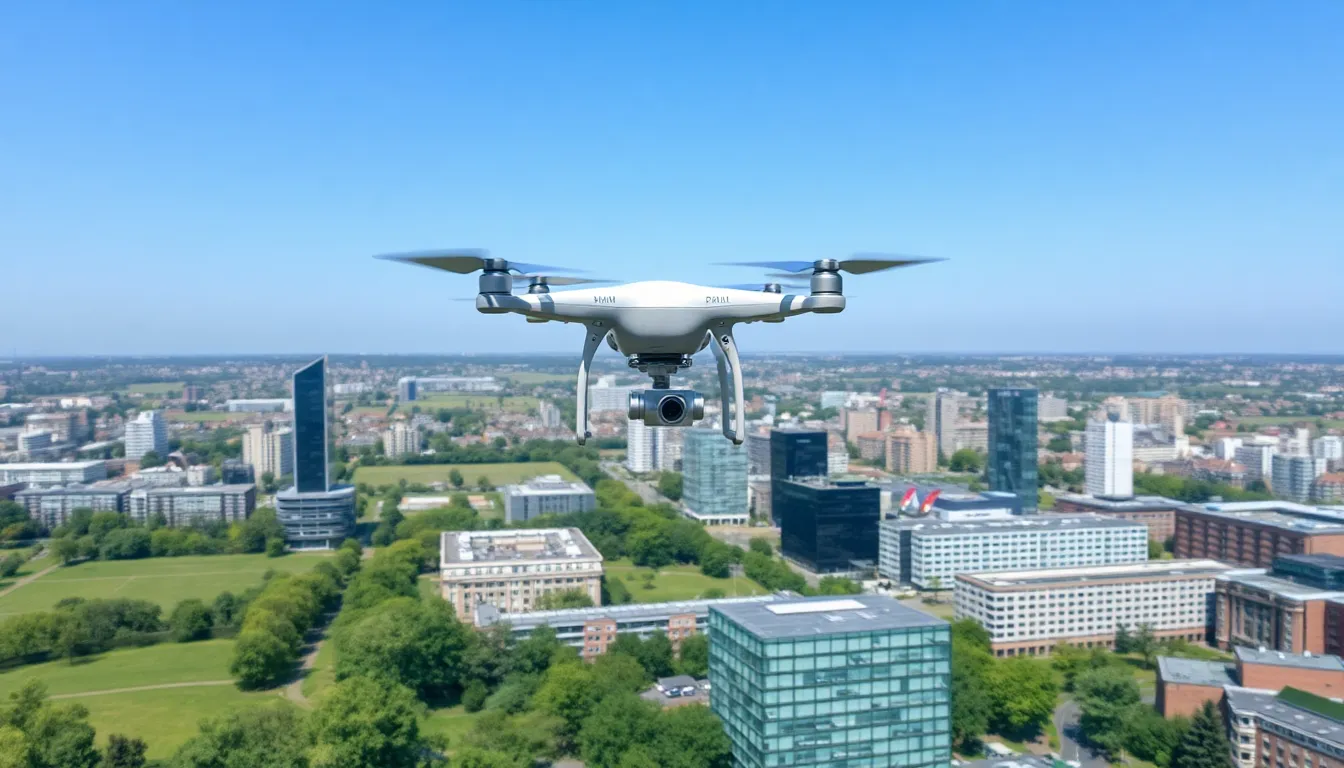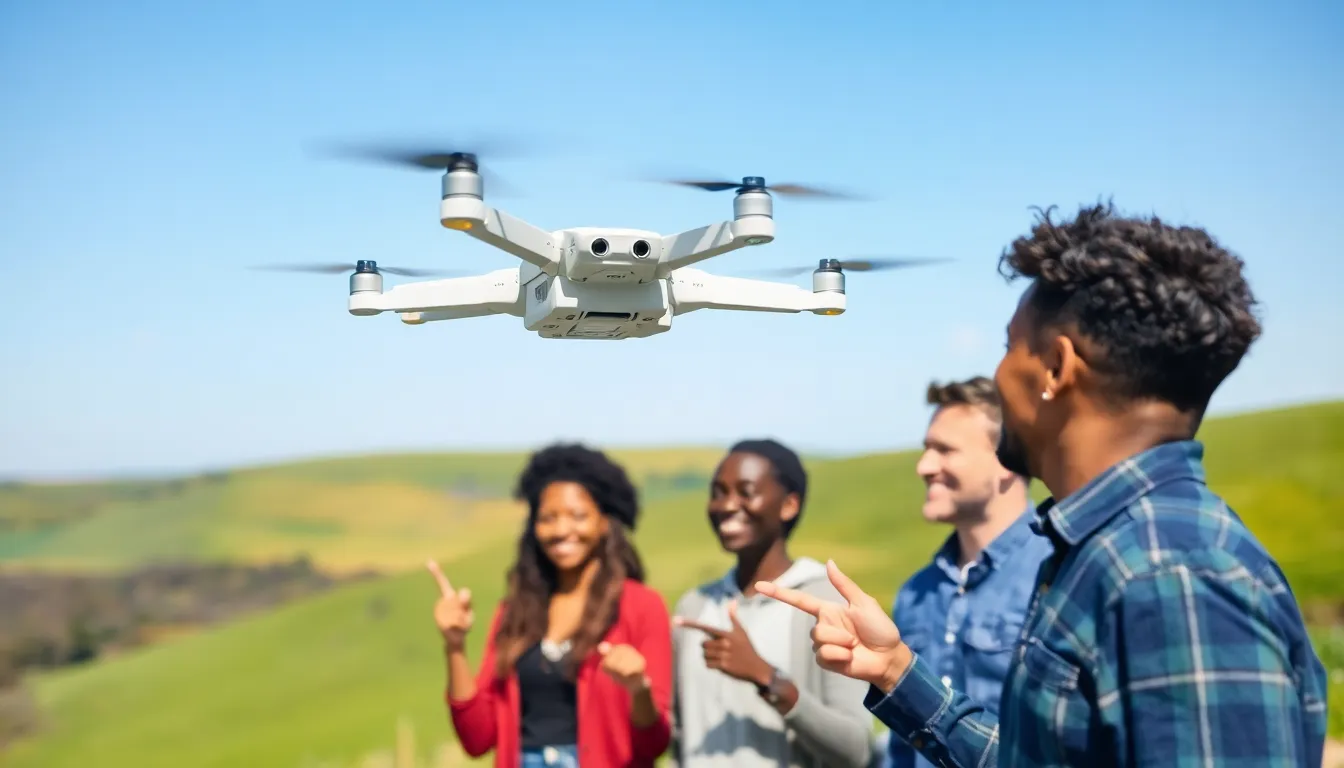Drones are no longer just the toys of tech enthusiasts; they’ve taken the UK by storm, buzzing into various industries and everyday life. From delivering pizza faster than a hungry teenager can say “I’m starving” to capturing breathtaking aerial shots that make even the most mundane landscapes look like a postcard, these flying wonders are changing the game.
But it’s not all fun and games—there’s a serious side too. As regulations tighten and technology advances, understanding the ins and outs of drones in the UK becomes essential for everyone from hobbyists to businesses. So whether you’re looking to take to the skies or just want to know what all the fuss is about, it’s time to dive into the world of drones and discover how they’re reshaping the landscape, one flight at a time.
Table of Contents
ToggleOverview of Drones in the UK
Drones in the UK span various sectors, demonstrating significant versatility and innovation. The commercial use of drones has skyrocketed, with reports indicating a market size projected to reach £1.5 billion by 2024. Industries such as agriculture, construction, and film production rely heavily on drone technology for efficiency and cost-effective solutions.
Several regulations govern drone usage in the UK. The Civil Aviation Authority (CAA) oversees these regulations, ensuring safety and compliance. Pilots must register their drones and complete training courses, especially for commercial operations. These measures support responsible drone operation and minimize risks in the airspace.
Drones also benefit everyday consumers. Food delivery services and adventure tourism have begun incorporating drone technology, enhancing customer experiences. Many photographers and videographers now utilize drones for stunning aerial shots, capturing perspectives previously unattainable.
Public acceptance is growing. Surveys highlight that around 70% of the population sees the value of drones in industries like emergency services and environmental monitoring. Such insight showcases the potential of drones to improve public safety and provide valuable data for community initiatives.
Technological advancements continue to propel the drone industry. Innovations in battery life, camera capabilities, and AI integration pave the way for smarter, more efficient drones. These developments promise to revolutionize various processes, enabling new applications that enhance productivity and creativity.
Overall, the evolution of drones in the UK exemplifies a shift towards dynamic solutions in multiple spheres of life, encouraging wider adoption and exploration.
Regulations Governing Drones in the UK

Drones in the UK operate under stringent regulations that ensure safety and responsibility. The Civil Aviation Authority (CAA) oversees drone usage, mandating registration for all pilots. Pilots must complete training to attain competency and understand airspace regulations.
Current Legislation
Current legislation focuses on several key regulations that govern drone operations. Operators in the UK must register their drones if they weigh over 250 grams. Additionally, pilots must follow the Air Navigation Order 2016, which outlines rules for flights in controlled airspace. Restricted zones include airports, military sites, and urban areas, where additional permissions are necessary. Compliance with these regulations minimizes risks and enhances public trust in drone technology.
Future Developments
Future developments in drone legislation will likely adapt to technological advancements and growing demand. Enhanced legislation might include more tailored rules for commercial operators, especially in sectors like agriculture and delivery services. The introduction of designated drone corridors could facilitate safer flights within urban environments, promoting efficiency. Privacy laws may also evolve, ensuring individual rights are protected as drones become more prevalent. The CAA is expected to regularly update guidelines to anticipate and reflect changes in drone technology and societal needs.
Applications of Drones in the UK
Drones demonstrate remarkable versatility in their applications across various sectors in the UK.
Commercial Use
Construction industries leverage drone technology for surveying and project management. These unmanned aerial vehicles provide real-time data that improves decision-making and expedites workflows. Agriculture relies heavily on drones for crop monitoring and precision farming. Farmers utilize drones to assess plant health and optimize irrigation practices effectively. In film production, filmmakers capture stunning aerial footage, enhancing visual storytelling. The commercial drone market in the UK is projected to reach £1.5 billion by 2024, reflecting extensive adoption across these industries.
Recreational Use
Drones serve recreational purposes for hobbyists and adventurers alike. Photography enthusiasts use drones to capture breathtaking landscapes and dynamic events from unique perspectives. Adventure tourism embraces drones for guided experiences and aerial sightseeing, enhancing overall enjoyment. Families and friends explore drone racing, a thrilling activity gaining popularity in urban areas. Community events increasingly feature drone-related activities, fostering social interaction and engagement. Public acceptance continues to grow, with surveys indicating that 70% of the population values drones in various sectors, including leisure.
Challenges Facing Drones in the UK
Drones face notable challenges in the UK despite their growing popularity and applications.
Privacy Concerns
Privacy concerns emerge as a significant issue with increasing drone use. Many individuals worry about unauthorized surveillance and data collection. Public sentiment indicates apprehension, especially in residential areas, where privacy violations could occur. Regulations might evolve to address these worries, ensuring standards that protect citizens’ rights. The UK’s existing privacy laws may require revision to adapt to drone surveillance capabilities. Addressing these issues is crucial for gaining public trust and acceptance. Organizations deploying drones must implement measures that respect privacy while utilizing drone technology effectively.
Safety Issues
Safety issues present another challenge for drone integration into everyday life. Airspace congestion rises as commercial drone usage escalates. Risks of collisions with manned aircraft or obstacles increase without effective regulatory measures. Pilots must adhere to the Air Navigation Order 2016, ensuring compliance with safety protocols. Training and registration through the Civil Aviation Authority remain essential for reducing accidents. Advanced technology can enhance safety features, such as collision avoidance systems. Continued focus on safety will help mitigate potential dangers associated with drone operations.
The landscape of drone technology in the UK is rapidly evolving and presents exciting opportunities across multiple industries. As businesses and consumers alike embrace these innovations, the potential for enhanced efficiency and creativity continues to grow.
While challenges such as privacy concerns and safety regulations must be addressed, the benefits of drones are becoming increasingly clear. With ongoing advancements in technology and adapting legislation, the future of drones in the UK looks promising.
As the market expands and public acceptance rises, it’s essential for users to stay informed and engaged with the evolving regulations and best practices. This dynamic industry is set to transform how people interact with technology in their everyday lives.




